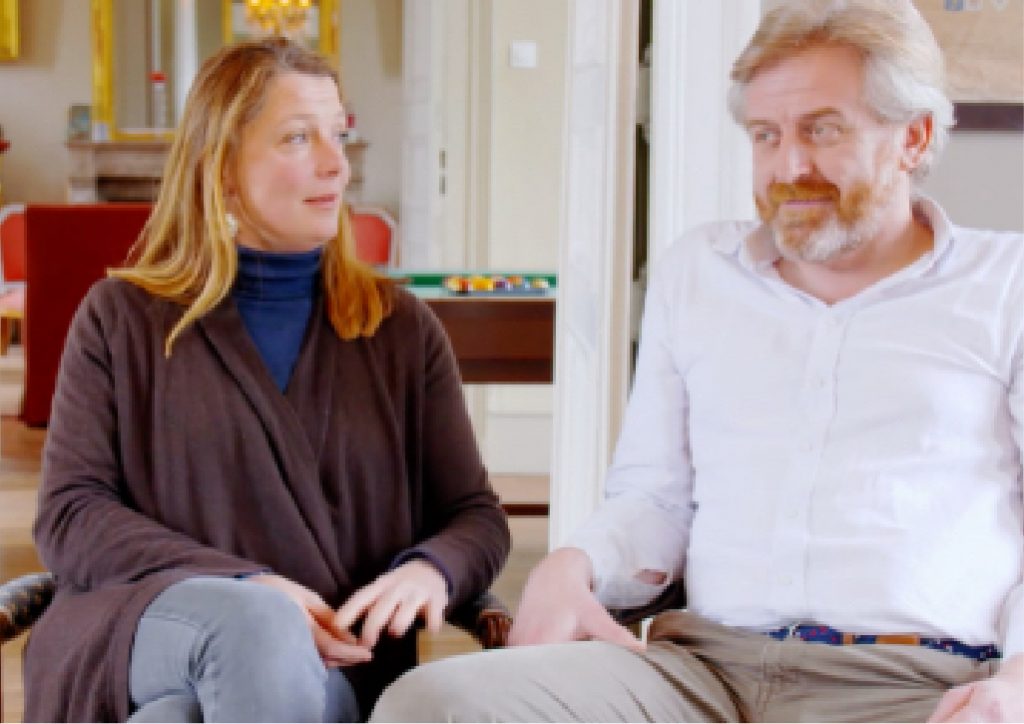Château Flore
Ithaca and Alex
There are various reasons people become a château owner.
Some get hooked when they watch the show.
For others it’s an ambition they’ve had since childhood.
A few are persuaded by their partners.
But for Alex and his wife Ithaca there was no decision needed to buy.
The Château Flore has been in his family for over 400 years, so he was already an owner when they met.

Château Flore. AKA Château d’Humeroeuille
This 18th century building in the Pas-de-Calais department in the Hauts-de-France region of France is actually named Château d’Humeroeuille after the town in which it was built between 1714 and 1717. But its owners and locals recognise it by its nickname: Château Flore, or Plant Castle.
Famous for its beautiful gardens
It’s different from other châteaux, because its gardens are now as famous as the building. They are not as old though, having been created in their present form as recently as 1985. Today there are more than 100 varieties of hydrangea there, as well as an English lavender parterre, or raised flower bed, made of 480 plants.
Fairs and festivals
In normal times the two-hectare garden is also the site of an annual plant festival and antiques fair along with other events.
And it’s just as popular an attraction with visitors as the Château building.
Ithaca was presumably enchanted by it too, as she’s a nature lover and comes from a family of gardeners.
Planning a trip to France?
Saved by the family, for the family
When Alex took over the Château and grounds in 2011 it was in a sorry state. It’s a massive undertaking to look after one of these big buildings, and a drain on both the owners time and money.
If you’re not on top of it all the time it doesn’t take long for it to fall into disrepair.
The family were considering selling the property and grounds when Ithaca and Alex decided to step in.
Raising finance
At the time Alex worked for a TV company and had also set up a local insurance company with his brother. Ithaca worked for a non-profit organisation that helps to turn around companies that were facing difficulties. This work provided some of the cash injection needed to get the Château into a better state.
However the pair still had to borrow money to take on the necessary repairs and renovation. To make their task more complicated, the château is a listed building, so they needed to get permission before they could make any necessary changes.
French bureaucracy is notoriously difficult to negotiate and it helped that Alex is French. Although even he, at times, found it a challenge.
Work, no rest and no play
Finding the necessary time to devote to the building was equally problematic.
Working full time and looking after a château meant early starts, late finishes, and long weekends without respite.
So when asked what they do in their spare time, the couple reply is what spare time?
Any time they have free is immediately put to use working on the next renovation job.
Only on very rare occasions is there the opportunity to sit in a bath with Epsom salts, or relax for a few minutes with a gin and tonic.
Learning on the job is part of the job
However, if you have to keep an eye on your finances there simply isn’t any alternative to working hard on DIY when you take on a château. French skilled manual labour is both expensive and difficult to get hold of.
And if you haven’t the necessary skills to start with, you’ll probably have learnt them by the time the building has been improved.
Keeping it in the family
Ithaca and Alex aim to keep the building in the family – which means not allowing it to be run down and get into a state that leaves their children, Jules and Violet, with a burden, that they might have to sell. In other words, they want to pass on the château in the best state possible.
Growing up in the château
Jules was a toddler and Violet just five when they moved in, so they’ve grown up in the château. Like most kids, now they are teenagers they have a yearning for city life, and the countryside is sometimes a little too quiet for them. But they are very appreciative of the space that they enjoy at home and in the gardens.
Beautiful gardens – and that will be official
Ithaca and Alex manage all the ongoing renovations on the château, as well as devoting an equal amount of time to the gardens.
Their aim is to get various appropriate accreditations and government status that the garden is approved and beautiful. It’s a big draw to the public and open from mid-June until the end of September.
There are also plans to renovate the gardeners house that dates back to 1680, so it can serve a guest house.
Making a show of it
The couple also host various events throughout the year in their gardens, including a brocante and flower fair in June and an October “glo-fest” that involves dozens of carved pumpkins on display, roasted chestnuts and a children’s treasure hunt. So far, they have resisted requests to open a tea shop too – they’re simply too busy with their full-time jobs, and their immediate focus is on completing all the refurbishments and redecoration.
Any money they make on events goes straight back into funding projects in the house or gardens.
A historical monument
The château is listed in the supplementary inventory of historical monuments.
And is slightly small to be ranked as a château or castle – although it’s still an impressive size in comparison to any conventional home!
Surviving the revolution
It was enlarged during the restoration and then partly destroyed during the French Revolution around 1792 or 1793.
After the revolution it was passed on by the owners to Morel de Belvalet by the marriage of his grand-daughter Marie de Belvalet, whose family own it until this day, thanks to the efforts of Ithaca and Alex.
Looking for inspiration
The pair look to various British books written around the time the château was built as inspiration to help them decorate. And Ithaca browses through archived Farrow and Ball Designer Colours as a guide, a practice that has led to significantly more colour on show than you’d traditionally expect to see in a French house.
Finding antiques that fit with the château
They are also constantly on the look-out for unique objets d’art in brocantes to display. She’ll also choose items from the brocante that they host in their own gardens when local antique dealers come along to put all their items on display. She describes the experience as being like a five-year-old child let loose in a sweet shop!
Other ongoing tasks are more mundane. For example, the main outbuildings need redoing completely, and their roofs are falling down.
Listing restricts what you can do
There’s also a challenge with restrictions on what they are allowed to do.
The facades are listed because there are so few châteaux from the early 18th century that exist in the region. The staircase dating back from 1717 is listed too, because it was deemed exceptional by the government. Archives show that when the property was ransacked during the French revolution, it was one of the only original features to survive.
Covid-19
The pandemic restricted access to the buildings, but Ithaca and Alex kept the gardens open from June until September. Ithaca says that it’s good for the mind and body to be outside and they wanted people to enjoy their space. They even extended the open hours to allow people to provide a safe haven and let people relax outside.
Being on the Show
They didn’t know what to expect when they were invited to take part in the Château DIY show. But they found it a rewarding experience.
It’s given them more exposure, and now they are on the international map with enquires from around the globe. The best thing about it, Ithaca says, is the support they get from the other château owners. Because they all experience the same trials and tribulations they can understand the challenges and the triumphs of running and renovating a big house, better than family and friends.
Top tips
If you decide to take the plunge and invest in a château too, the couple’s advice is don’t be afraid to get dirty!
Get physically involved and accept that there will always be loads of different jobs to do.
Ithaca wears a jacket inside and outside too, as it sometimes gets cold. And she carries secateurs, tape measure and mobile in her pocket, because she never knows when she might need to take a picture, measure something or take a cutting.
Know when you need help!
But as well as doing all the DIY the couple have found out you also need to know when to call in professional help too.
Patience, too, they say is a virtue. So you have to learn to accepting that you can’t do everything straight away.
Who knows if the Château Flore will stay in the family for another four hundred years or not.
But, thanks to Ithaca and Alex, Jules and Violet, you can be confident that it’s not going to be sold for at least another generation.
Booking Enquiries
Find out more or to book a stay – contact the owners here

